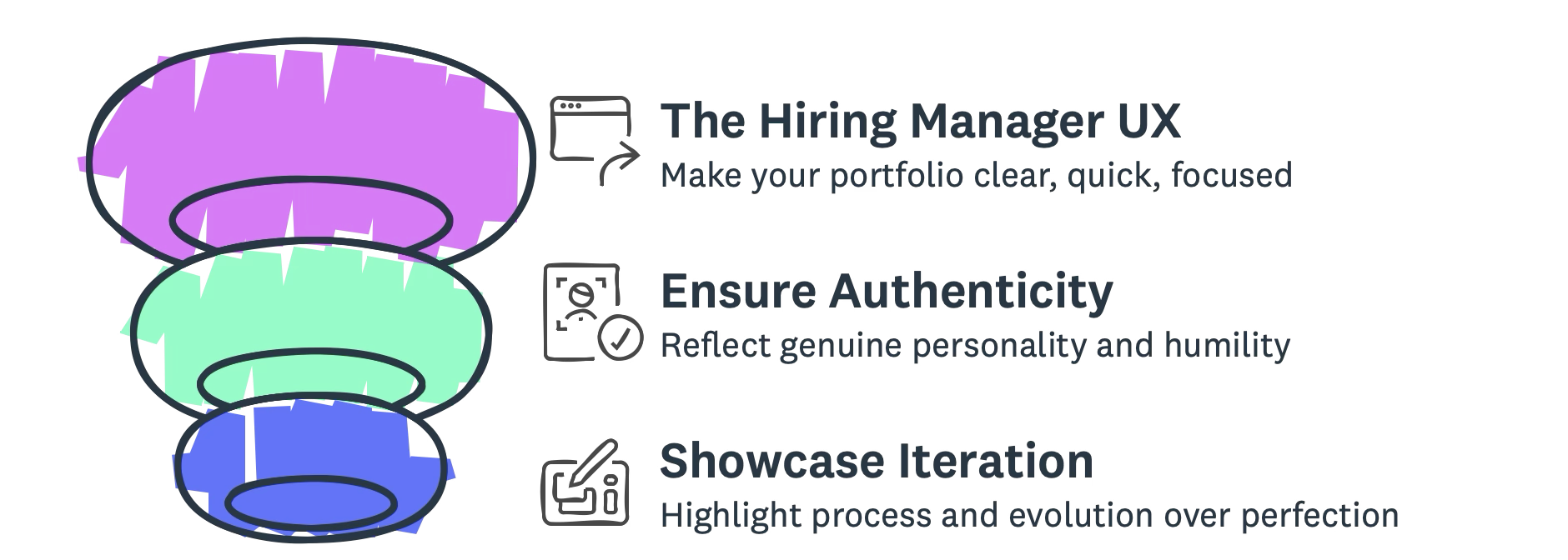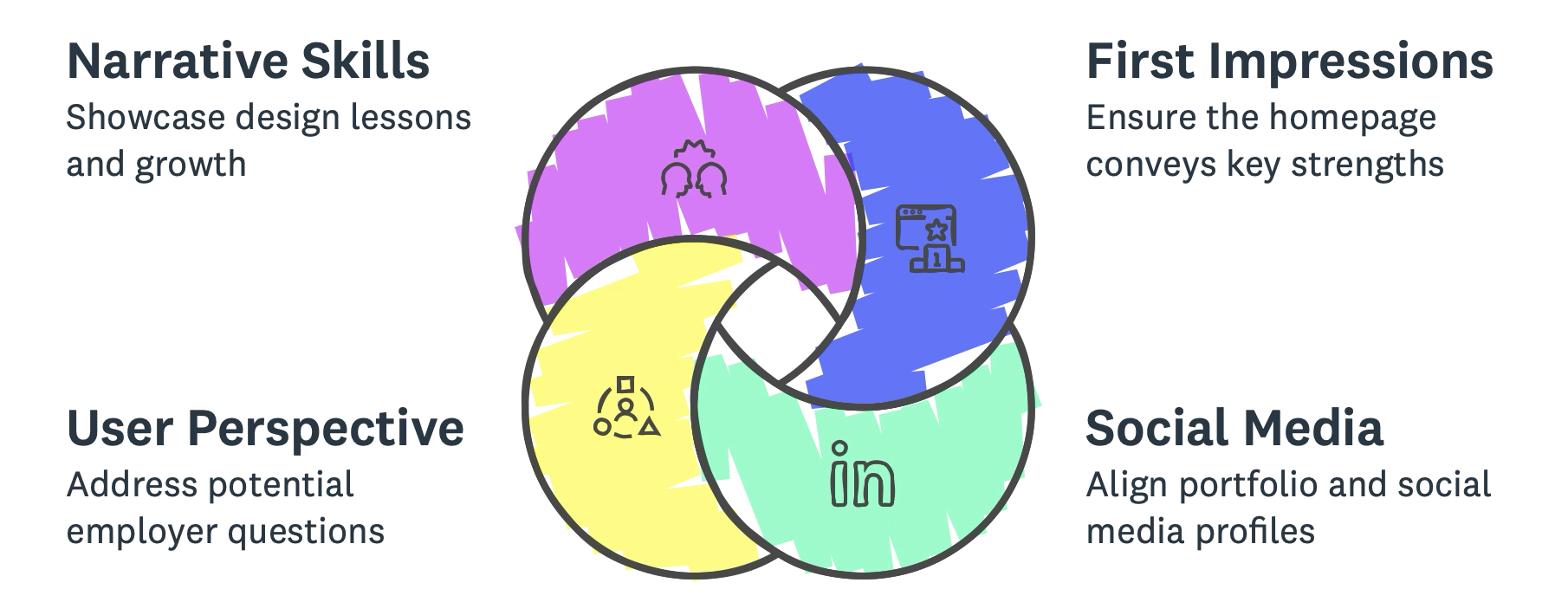Building a Standout Portfolio
Since I began my journey in digital design—ranging from leading complex transformation projects at large consulting firms to shaping innovative SaaS experiences in Silicon Valley—one thread remains constant: the power of a well-crafted portfolio. It’s not just a vehicle to showcase your work; it’s often your first conversation with potential collaborators, employers, and clients.
I recently revisited some material I shared with General Assembly students, centered on how to develop an online portfolio that resonates with potential employers and truly reflects your design process . If you’re aiming to grow your career in UX or product design, or you just want your work to shine through authentically, these three themes might help guide your approach.
1. Design a Great User Experience for the Hiring Manager
Just like any product or service, your portfolio should deliver a clear, accessible, and engaging experience for its “users”—in this case, recruiters, potential clients, and hiring managers. From my own work helping clients shape consumer- and enterprise-grade software, I’ve learned the value of clarity:
Quick – People reviewing portfolios often move fast and have limited time. Present your best work upfront, with concise project summaries and easy navigation.
Focused – Highlight the core challenge, your role, and the key outcome. Many hiring managers scan quickly, looking for relevant experiences or unique thinking.
Complete – Include enough detail to show how you tackled the problem, but don’t let every minor detail obscure your main narrative. A streamlined case study that’s thorough but to-the-point will demonstrate impact effectively.
When I was reviewing design talent for multiple client engagements—whether at a major utility, a healthcare startup, or a cloud software provider—I looked for portfolios that quickly helped me see the candidate’s thought process. The faster you can orient someone to what you did and why it mattered, the stronger the impression you’ll make.
2. Be Authentic—Show Who You Really Are
Authenticity is a driving force in building credibility and connection. Whether I’m advising a budding designer or consulting with top-tier clients, there’s no substitute for honesty about your skills, lessons learned, and personal voice.
Psyche, Not Quirky: It’s great to have personality, but don’t confuse forced quirkiness with genuine passion. Make sure everything—your tone, your visual style, even your color palette—reflects who you really are.
Humble, Not Brag: Discuss your wins, but put them in context. Talk about collaborators, challenges, or constraints along the way. This humility goes far in showcasing your ability to work in a team.
Learn, Not Perfect: If your portfolio only shows polished final screens, it can come across as disconnected from real-world problem-solving. Embrace your mistakes and your learning process.
From my own experience collaborating with cross-functional teams—especially in fast-paced startup environments like Docker—I found that the best designers are those unafraid to show they don’t have all the answers at first but can learn rapidly. This honest vulnerability translates exceptionally well when you document your journey in a portfolio.
3. Show Iteration—Process Over Perfection
In many of my engagements—be it launching a next-gen healthcare platform or spearheading a new AI-driven feature—rapid, iterative experimentation is the path to success. Your portfolio should capture this evolution. Employers want to see how you move from initial concept to refined execution:
Not Just “UXD Process”: Go beyond generic “research → wireframe → final design” evidence. Instead, share very specific vignettes on how you applied user insights, overcame unforeseen obstacles, or adapted to feedback.
Progression: Show multiple variations of a screen or feature, explain what changed, and why you pivoted. That nuance helps people understand how you handle real-world challenges.
During a workshop for General Assembly, we walked through the difference between throwing up a single polished image vs. highlighting the steps that got you there. Prospective employers know design is messy and iterative; they want to see that you’re capable of learning, adapting, and improving—and that you can articulate your decision-making along the way.
Final Tips: Make it Count
First Impressions Still Matter: Just like a product landing page, your online portfolio’s homepage should give people a quick read on who you are and what you do best. Keep mobile users and short attention spans in mind.
Social Media + LinkedIn: Ensure consistency across your portfolio, resume, and social media profiles. You might be surprised how often a potential hiring manager not just checks your LinkedIn but Googles you and visits your Insta.
Put Yourself in Their Shoes: Remember, the person reviewing your site has their own questions: Are you skilled or talented? Will you fit their needs? Are you a good cultural match? Design your portfolio to answer those unspoken questions quickly and convincingly.
Reflecting On My Own Journey
Having built and led design teams that serviced Fortune 500s and ambitious startups, I see portfolios as a microcosm of your design philosophy. The best portfolios are more than a static gallery; they’re a compelling story of your design skills, thinking, and growth. By embracing user-centered structure, authenticity, and an iterative mindset, you’ll ensure that your portfolio is differentiated—by telling a meaningful narrative of who you are.
Let’s connect and discuss if you’re looking for more insights on how to integrate these principles into your portfolio. I’m always excited to swap stories, compare experiences, and help fellow designers grow in our evolving field.
Thanks for reading, and remember: building a powerful portfolio is an ongoing process—just like design itself.

